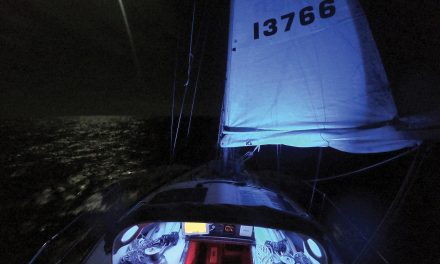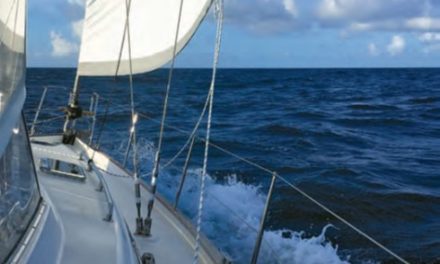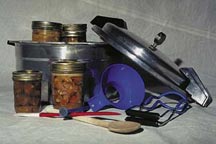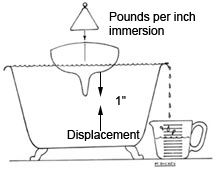A drift down the fairway provides a lesson in boat handling and hubris
Issue 150: May/June 2023
 I spent the first six years of my sailing life sailing my fin-keeled 1980 Hunter 36, Gudgeon, and for most of that time I was in a fairly tight marina space. After a bit of practice, I was able to spin the boat easily around in her own length and quite happily navigated all sorts of tight spots and unfamiliar marinas.
I spent the first six years of my sailing life sailing my fin-keeled 1980 Hunter 36, Gudgeon, and for most of that time I was in a fairly tight marina space. After a bit of practice, I was able to spin the boat easily around in her own length and quite happily navigated all sorts of tight spots and unfamiliar marinas.
Thanks to this, I had a level of confidence and security in my own abilities at boat handling that were about to be firmly dashed.
My next boat couldn’t have been more different — Sooner is a Rafiki 37 and was only a foot longer, but she was literally twice the displacement and had a very full keel. And when I say a full keel, I mean a full keel, with 6 feet of draft from the front of the boat to the back. The first time I hauled her out to bottom paint, standing next to the keel was like standing next to a brick wall. She also has a transom-hung rudder, which could charitably be described as having a barn door aesthetic and more realistically as horrendously inefficient. Compared with the balanced spade rudder of my old boat, it was like handling an oil tanker.
 The first time I tried to take her out of the marina solo with a bit of a crosswind blowing, my confidence in my abilities collided with reality. The marina where she was docked is notoriously a bit of a pain to get out of — the fairway between the slips is only a few feet longer than the boat, and a north wind blowing will push you further down the fairway. If you can’t make the turn in time, you are blown helplessly down the fairway sideways.
The first time I tried to take her out of the marina solo with a bit of a crosswind blowing, my confidence in my abilities collided with reality. The marina where she was docked is notoriously a bit of a pain to get out of — the fairway between the slips is only a few feet longer than the boat, and a north wind blowing will push you further down the fairway. If you can’t make the turn in time, you are blown helplessly down the fairway sideways.
Which, uh, is exactly what happened.
 Full of hubris, I had waved away kind attempts to help me leave the dock with a perfunctory “No, I will be totally fine” (I wasn’t) and “I’ve done this before lots of times” (I hadn’t).
Full of hubris, I had waved away kind attempts to help me leave the dock with a perfunctory “No, I will be totally fine” (I wasn’t) and “I’ve done this before lots of times” (I hadn’t).
Reversing out went fine initially, as I had handbombed the boat so it was going to reverse at a slight angle, and I backed out enough to where my bow would clear the boat in front. Shifting into forward gear to make the turn, the bow swung around slowly, agonizingly close enough to make the turn, before the (quite gentle) wind caught it and pushed it back. I switched back into reverse and tried again, with more power to try to force it round. And again. And again.
At this point, all the noise and commotion had attracted the attention of everyone at the docks, which, as it was a lovely late summer weekend day, was quite a crowd. People began to shout advice, most of it wildly contradictory, as I slowly drifted sideways down the fairway while I busied myself moving back and forth on the throttle to avoid bumping into any of the boats on either side and throwing myself over the side in embarrassment.

 I eventually ended up resting gently against the end of the fairway and was immediately surrounded by an excited group of tourists, grizzled sailors, and a couple of hungry seagulls.
I eventually ended up resting gently against the end of the fairway and was immediately surrounded by an excited group of tourists, grizzled sailors, and a couple of hungry seagulls.
At this point I basically wanted to just go below and pretend that the boat belonged to someone else, but I needed to get off the dock. Luckily, I spotted George, a neighbor who owned a very similar boat. He suggested backing down on a floating springline attached to the rear of the boat and looped around a cleat on the dock and rotating off a fender — which, combined with a hearty shove and a boathook on the bow, got me facing the right direction. With a burst of power, I was off.
I’d managed not to hit anything during my undignified sideways drift and the only casualty was my pride, which can be repaired a lot cheaper and easier than fiberglass or wood.
Matthew Parsons has lived aboard and sailed since 2014. He sails his newest boat, Sooner, out of Victoria, British Columbia, and can be found on Instagram at sail_dive_fish or at saildivefish.ca.
Thank you to Sailrite Enterprises, Inc., for providing free access to back issues of Good Old Boat through intellectual property rights. Sailrite.com





